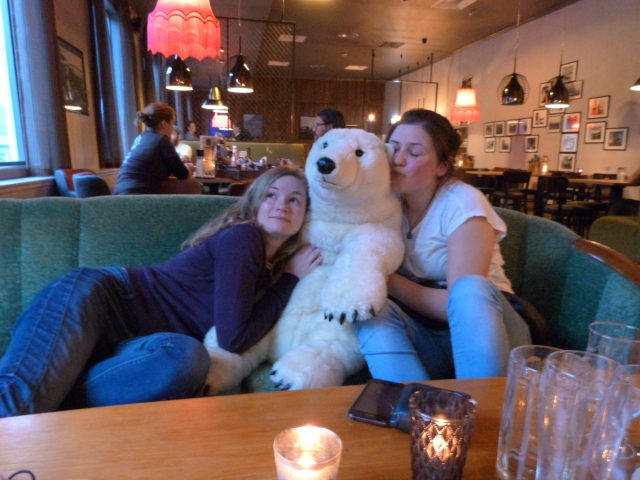Having spent time getting excited by the local flora and fauna came the day I was most looking forward to- the ice! Course tutor Ed had shipped up lots of radar and GPS equipment to Ny Alesund before our arrival so our first job was to work out how to distribute it all among us to carry up to Midrelovenbreen, the glacier we were going to be working on.
Once we were all loaded up we walked out to the glacier and split into teams on of which used GPS to plot out a path up the glacier, then they were followed by the team with the ground penetrating radar. The radar is on a sledge that would normally be pulled by a skidoo but Ed had decided that as he had a handy supply of PhD students he could use us.

Team sledge dog pulling the radar equipment along the glacier (twice as someone forgot to turn it on the first time…)
We were able to attach some show chains to our boots that allowed us to walk on the glacier without falling all over the place. The path up the glacier was marked out initially by piles of rocks by the GPS team, and then spare team members as the surface of the glacier became far less rock covered the further up we got. 20 years of education to get to pretend to be a rock…

We stopped at the top of the glacier for lunch and a quick sunbathe.

After lunch at the top of the glacier we were shown a melt river that in some places was completely hidden by a layer of snow and ice over the top- a reminder that even a glacier that feels very safe can have hidden surprises.
Once we were back to Ny Alesund a few of us still had some excess energy so decided to go for a hike up towards the atmospheric research laboratory on a hill near to the town. This was our first time out on our own without a course leader so we were hopeful for no bears. Due to the measurements they’re taking at the lab we couldn’t get too close but we still managed to get high enough to get some excellent views of Ny Alesund even if it was much more of a climb than a hike. The decision to go back down the shale front tested my balancing skills to their maximum, although little did I know that we were being checked up on through the base telescope and probably providing quite a lot of entertainment into the bargain.

A fairy steep and chilly climb up…

But worth it for excellent views of Ny Alseund and this glacier behind the mountain.
Once back at the base we had a chance to look at our biological samples and review Ed’s images from the radar.
The next day it was sadly time to head back to Longyearbyen but this was made slightly more bearable through it being via a stunning flight over the ice caps.
Our final meal of the trip provided an opportunity to finally meet a bear, thankfully our rifle training wasn’t necessary.









